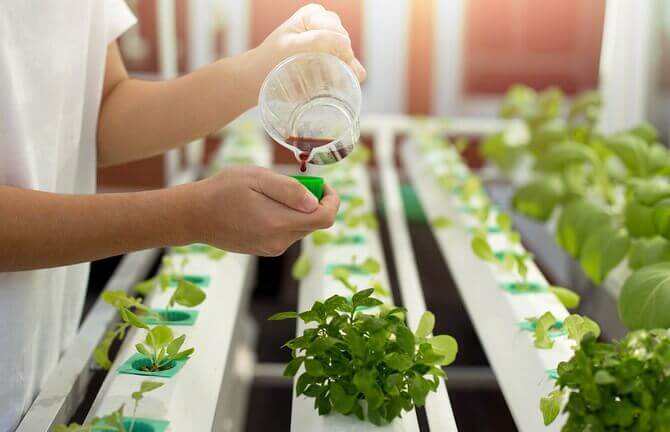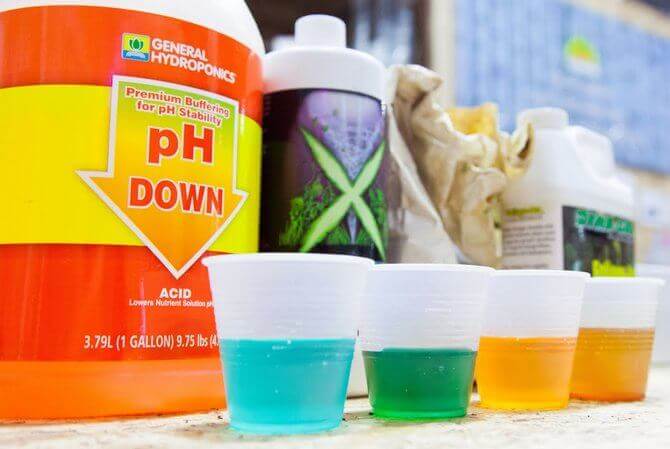
Nutrients for hydroponic farming – what your plant needs?
You know that growing plants hydroponically is impossible without the proper nutrients. This method of growing helps save water while producing more yield. If you own a plant business, this method can change the way you work.
Once you get the hang of it, you may want to expand. How can you make nutrient management the linchpin of your system? For example, you can consider an automated plant growing system. These smart controls can transform your small plant growing into a high-yield system.
More importantly, you can monitor the entire process from one screen. So you don’t have to be there all the time to see how your hydroponic system is thriving. But first, let’s talk about the importance of nutrients for hydroponic farming.
What are hydroponic nutrients and why do you need them
Hydroponic nutrients refer to the plant nutrients that are appropriate for hydroponics. With this system, you have complete control over your plants’ nutrients. However, people often question the safety of this process. But don’t worry!
The hydroponic process is safe for both the environment and your plants. First, of course, you need to familiarize yourself with the process.
Get familiar with the nutrients for hydroponic farming
Most plants depend on a few general nutrients. These include CO2, hydrogen, and oxygen, which are naturally present.
The remaining nutrients are divided into primary macronutrients and micronutrients.
There are a total of 17 essential nutrients for plant growth. These nutrients come from water, soil, and air. Based on specific properties, these nutrients are divided into macronutrients and micronutrients.
There are 3 top critical macronutrients and 5 top micronutrients. Without these 8, plants cannot survive.
Top-3 macronutrients
- Nitrogen (N). Plays a crucial role in the plant’s energy metabolism. It’s necessary for the overall development and growth of plants.
- Phosphorus (P). Is involved in several important aspects of plant growth and survival. It stimulates root growth and also improves the plant’s climate endurance.
- Potassium (K). Is necessary for the uptake of nitrates, and nitrate (which contains Nitrogen) is required for all plant growth. Potassium also regulates water transport and affects plant photosynthesis. This makes it vital for the plant.
Top-5 micronutrients
- Boron (B). Is necessary for the control of plant growth. It influences sugar transport and cell growth.
- Chlorine (Cl).Is necessary for photosynthesis in plants. Without photosynthesis, plants cannot produce their food.
- Copper (Cu). Is necessary for the activation of various enzymes in the plant body. It’s also necessary for seed production. You don’t want your plant to be copper deficient because Copper deprivation can make the plant susceptible to many diseases.
- Iron (Fe). Is a critical component of the plant electron chain. Plant metabolism is impossible without iron.
- Manganese (Mo). Is the core of the chlorophyll molecule. A deficiency of manganese can therefore lead to low photosynthesis.

Important to chose the right type of hydroponic nutrients and following dosing instruction.
How to choose the right type of nutrients for your plants
Since there’s no soil, the plants rely on hydroponic farming nutrients. With a fully automated hydroponic system, you can add them directly to the roots of the plants. You can even use nutrients that are in powder form.
When you go to a plant fertilizer store, you may be confused by the different types of fertilizers. You’ll find organic and synthetic nutrients. Then you’ll see that they come in different varieties.
Honestly, choosing the right fertilizer is more complicated than you might imagine. But we’ve got you covered! We’ll give you the tips you need to select the right kind of nutrients for your plant. So let’s get started.
Organic or Synthetic
The first thing you need to decide is whether you want to use organic or synthetic nutrients. What’s the difference between the two?
- Organic nutrients are made from natural elements. They consist of plant and animal wastes. No chemicals are used in their production.
- Synthetic nutrients, on the other hand, are made by humans. They consist of various chemicals. They’re entirely artificial but function like organic nutrients.
If you want to play it safe, you should use organic fertilizers. Since they’re natural, they have no side effects on the plant. They’re the best choice for long-term use.
Synthetic fertilizers, on the other hand, are ideal for multiple plants. You can use them to boost production temporarily, but you’ll see some setbacks on the plants.
So as you see, it’s always better to choose organic nutrients to play it safe.
Nutrient Ratio
Next, we need to choose the nutrient ratio. The nutrient ratio refers to the balance of Nitrogen (N), Phosphorus (P), and Potassium (K). The N-P-K ratio.
The ideal nutrient mix for hydroponic plants should contain all three nutrients. You should opt for the 5-5-5 ratio of N-P-K. The 5-5-5 ratio means that each of these three essential nutrients is included at 5%. This is a safe percentage.
Please keep in mind that no one size fits all when it comes to growing your plants.
Nutrient Form
The next point is the form of nutrients. There are usually three types of nutrients: Granular, Liquid, and Powder.
If your hydroponics is purely water-based, you should use powder or liquid nutrients. They excrete the water and reach the plant roots quickly.
Those are the three factors you can use to choose the proper nutrient for your hydroponic farming. However, keep in mind that some plants are different from the general public and need extra special care.

What to look for when purchasing hydroponic nutrients
When it’s time to buy hydroponic farming nutrients, you need to consider your options carefully. As we’ve mentioned above, there are dry nutrients, nutrient powders, or you can find liquid fertilizers. There’s a distinct difference in physical composition. To figure out which nutrient is best for you, look at these factors.
Concentration Levels
Solid nutrients are more concentrated than liquid nutrients. The main component of liquid nutrients is water. Powders tend to last a very long time. Liquids will stay with you for about a week. Also, powders have lower shipping costs and require less storage space. On the other hand, liquids are easier to inject.
Storage
Dry nutrients have a longer shelf life compared to liquids. Therefore, you can buy dry products in bulk without worrying about them expiring.
Usability
Dry products are trickier to use. It’s also hard to measure the exact ratios. Liquids are easier to weigh and distribute, especially in a fully automated hydroponic system.
Mixing and using nutrients correctly
Now let’s talk about mixing and correctly using nutrients. Proper manual use of nutrients can be tedious, and you can’t be sure of your success.
The modern hydroponic system is a boon to a home gardener’s ecological system. You can grow a variety of plants without using soil as a growing medium. Imagine what you can do with a properly developed grow room climate controller.
We at GrowDirector have introduced a comprehensive system that allows growers to control their plants. And it does it remotely, too! You can monitor and manage your plants even when you’re not around them.
There are a plethora of devices for proper plant care. You can adjust the light, temperature, and humidity in your garden. This closed-loop ecological system can drastically reduce water waste while delivering high yields.
The GrowDirector automated system uses hydroponic growing nutrients to achieve the optimal EC level. The system creates a fertilizer mix that meets your needs. The collected data prepares the required mixtures in the right proportions and distributes them throughout the plant. In this way, the automated system can take care of multiple nutrient ratios and take care of the plant. It also detects what the plant is lacking, as the method regularly monitors the growth and progress of your plant.
If you do it manually, you won’t be able to keep all the nutrients exactly, which can lead to an imbalance of nutrients in the mix.
In addition, the Grow Director devices can also maintain the moisture and temperature in the grow room with their hydroponic CO2 controller and other sensors. So this is how you can make and use the perfect hydroponic nutrient mix.
 Troubleshooting common nutrient problems and how to solve them
Troubleshooting common nutrient problems and how to solve them
Here are some common problems growers face while gardening.
Dispersing the right ratio of hydroponic nutrients
Making and using the correct ratio can be tedious manually. But with the GrowDirector system, this process is automated, and it can make precise mixtures (if the right equipment is used).
Dealing with copper deficiencies in younger leaves
Treating copper deficiency manually can be tricky as well. Too much copper can make the plant toxic, and a lack of copper can cause copper deficiency. But the Grow system can calculate and apply the necessary level of copper with the different sensors in the system.
Taking care of your plants when you are on vacation
The Grow Director is a fully-automated hydroponic-care system. It can handle the plants even if you are away for weeks. So take that vacation time with no guilt!
Conclusion
Listen, humans should follow a strict diet to stay healthy. Plants must do the same. They need lots of nutrients, fertilizers, and additives to grow appropriately. And it’s your job to make sure your plants have the selection of things they want.
Now you know what nutrients to use and when. With a solid automated hydroponic system like GrowDirector, you can get your crops in no time.
So whether you’re a beginner or a veteran, we recommend installing a Grow Director system. It can effectively reduce your labor and increase production. It can manage up to 2000 plants and multiple zones. Its simple plug-in design makes it universally applicable.
Although we are a young brand, we stand out for our reasonable prices and innovative solutions. We’re sure that we’ll find something for your hydroponic setting.